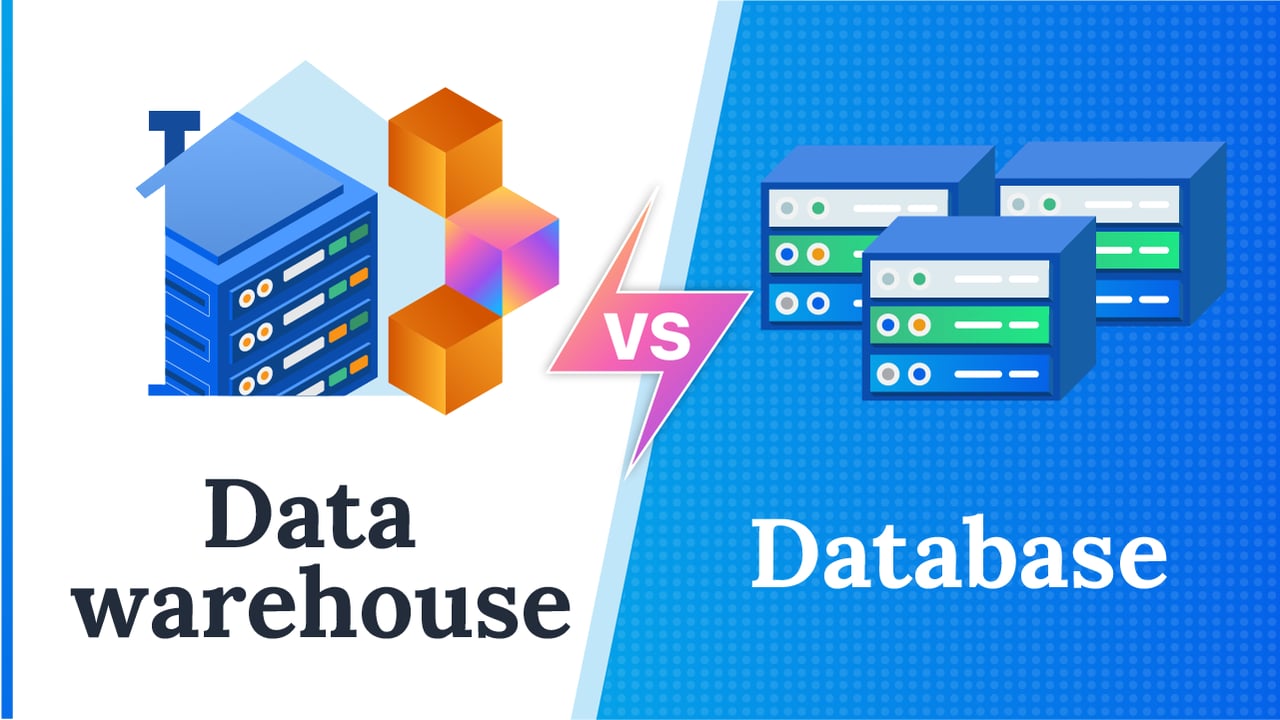
Introduction
In data management, two terms often emerge in discussions are "data warehouse" and "database." While both are essential components of modern data infrastructure, they serve distinct purposes and exhibit notable differences. Understanding these disparities is crucial for organizations aiming to optimize their data storage and analysis capabilities.
This blog post explores the comparison between data warehouses and databases, shedding light on their unique characteristics, use cases, and decision-making factors. We will explore these two systems' contrasting data structures, functionalities, and performance aspects. Additionally, we will examine the specific scenarios where data warehouses and databases excel and the various technologies and tools associated with each. By the end of this blog, you will have a comprehensive understanding of the critical distinctions between data warehouses and databases and be equipped to make informed decisions regarding their implementation in your organization.
A structure that defines the logical view of the entire defines how the data is managed and how the relations among them are associated. Taken From Article, Types of Databases with Benefits and Use Cases
What is Databases?
Databases play a fundamental role in managing and organizing structured data within organizations. They are robust repositories for storing, retrieving, and manipulating vast amounts of information efficiently and securely. A database is a structured data collection organized into tables consisting of rows and columns. These tables define the database schema, specifying the fields and their data types.
Databases offer various advantages, such as ensuring data integrity through constraints and enforcing data consistency with transactions. They provide powerful querying capabilities, allowing users to retrieve specific data using structured query languages like SQL. Additionally, databases support concurrent access, enabling multiple users or applications to interact with the data simultaneously.
Common types of databases include relational databases, where data is stored in tables with predefined relationships, and NoSQL databases, designed for handling unstructured or semi-structured data. Different database management systems (DBMS) like MySQL, Oracle, or MongoDB may be chosen depending on an organization's specific requirements.
Overall, databases are crucial for day-to-day operations, enabling efficient data storage, retrieval, and management, ultimately supporting the smooth functioning of modern businesses.
What is Data Warehouses?
In the era of big data and data-driven decision-making, organizations face the challenge of efficiently managing and analyzing vast amounts of information from multiple sources. This is where data warehouses come into play. A data warehouse is a central repository that integrates and stores large volumes of structured and sometimes unstructured data from various operational systems, such as transactional databases, CRM systems, and external sources.
The primary purpose of a data warehouse is to provide a consolidated, historical view of data that can be easily accessed and analyzed for business intelligence and reporting purposes. By transforming and organizing data into a consistent format, data warehouses enable organizations to gain valuable insights, identify patterns, and make informed strategic decisions.
Data warehouses employ techniques like Extract, Transform, and Load (ETL) processes to extract data from source systems, cleanse and transform it to meet specific requirements and load it into the warehouse. They also support complex querying and analysis through tools like Online Analytical Processing (OLAP), which facilitates multidimensional analysis and drill-down capabilities.
Data warehouses are a foundation for practical data analysis, enabling organizations to leverage their data assets and derive actionable insights for enhanced decision-making and competitive advantage.
Key Differences Between Data Warehouses and Databases
Data warehouses and databases have distinct roles in data management. Understanding their differences is crucial. This section highlights critical data structure, purpose, integration, querying, and scalability disparities.
Data Structure and Design
One significant difference between data warehouses and databases lies in their data structure and design. Databases typically follow a relational model, organizing data into tables with predefined relationships and enforcing integrity constraints. They prioritize transactional processing and support CRUD (Create, Read, Update, Delete) operations. In contrast, data warehouses employ a dimensional model, emphasizing optimized querying and analysis. They structure data into fact and dimension tables, allowing for complex data aggregations and slicing and dicing operations. This design facilitates efficient reporting and business intelligence activities, enabling users to gain insights from large volumes of data more intuitively and analytically.
Purpose and Usage
- Data warehouses and databases serve different purposes and have distinct usage scenarios. Databases are primarily designed for transactional processing, focusing on real-time data manipulation, storage, and retrieval. They are commonly used for operational tasks like managing inventory, processing customer orders, and maintaining transactional consistency.
- On the other hand, data warehouses are built explicitly for analytical purposes. They consolidate and integrate data from various sources to provide a historical, comprehensive view of the organization's data. Data warehouses are optimized for complex querying, data analysis, and generating reports and insights. They support decision-making processes, strategic planning, and business intelligence activities, empowering organizations to make informed decisions based on data-driven insights.
Data Integration and Consolidation
- Data integration and consolidation are crucial aspects where data warehouses and databases differ. Databases typically focus on managing data within specific operational systems or applications, maintaining data consistency and integrity within those systems. In contrast, data warehouses excel in integrating and consolidating data from multiple sources, including various databases, applications, and external data feeds.
- Data warehouses employ Extract, Transform, Load (ETL) processes to extract data from diverse sources, transform it into a unified format, and load it into the warehouse. This data consolidation gives organizations a centralized, comprehensive view, enabling more effective analysis and reporting across different data sets and systems. It facilitates cross-functional insights and a holistic understanding of the organization's data landscape.
Querying and Analysis Capabilities
- Regarding querying and analysis, data warehouses and databases differ in their capabilities. Databases excel at transactional processing and support real-time querying, focusing on retrieving and manipulating individual records or small subsets of data. They are optimized for quick response times and transactional consistency.
- In contrast, data warehouses are designed for complex analytical querying and analysis. They support advanced querying techniques like Online Analytical Processing (OLAP), which allows users to perform multidimensional analysis, drill-down, and data aggregations. Data warehouses provide a more extensive range of analytical functions and tools, enabling users to derive insights from large volumes of data, identify trends, and make strategic decisions based on comprehensive data analysis.
Performance and Scalability
- Performance and scalability are critical factors where data warehouses and databases differ. Databases are optimized for transactional processing, ensuring high-speed data manipulation and low-latency access for individual record transactions. They are designed to handle large volumes of concurrent transactions efficiently.
- In contrast, data warehouses prioritize analytical processing and query performance over individual transactional speed. They are optimized for complex queries and aggregations across massive datasets. Data warehouses are built to support ad-hoc querying, data analysis, and reporting, delivering optimal performance for these operations.
- Furthermore, data warehouses are designed to scale horizontally, accommodating growing data volumes and user demands. They can handle increasing data sizes and concurrent analytical queries by leveraging distributed processing and parallel computing capabilities.
A mini Data Warehouse design that shows the contents to be needed only to the client-side, i.e. it holds the overview of the data. Taken From Article, Data Mart in Data Warehouse and its Benefits
Use Cases for Data Warehouses and Databases
Data warehouses and databases have different use cases based on their functionalities. Understanding their strengths helps organizations determine when to leverage databases for transactional processing and when to employ data warehouses for analytical reporting and business intelligence.
Data Warehouses: Analytical Reporting and Business Intelligence
- Data warehouses support analytical reporting and business intelligence activities within organizations. By consolidating and integrating data from various sources, data warehouses provide a unified view of historical and current data, enabling in-depth analysis and reporting.
- With a data warehouse, organizations can perform complex queries, generate insightful reports, and conduct in-depth analyses across multiple dimensions and hierarchies. The dimensional structure of data warehouses facilitates slicing and dicing operations, allowing users to drill down into data and explore different perspectives.
- Data warehouses are a foundation for business intelligence initiatives, empowering decision-makers with accurate and comprehensive information. They enable the identification of trends, patterns, and correlations in data, helping.
- Organizations make data-driven decisions, improve operational efficiency, and gain a competitive edge.
- By leveraging data warehouses for analytical reporting and business intelligence, organizations can unlock valuable insights and extract meaningful information from their data assets, facilitating strategic planning, performance tracking, and informed decision-making.
Databases: Transactional Processing and CRUD Operations
- Databases are widely used for transactional processing, focusing on efficient data manipulation, storage, and retrieval for day-to-day operations. They excel at handling transactions that involve creating, reading, updating, and deleting data, commonly called CRUD operations.
- Transactional databases ensure data integrity by enforcing constraints and ACID (Atomicity, Consistency, Isolation, Durability) properties. They provide a reliable and secure environment for handling critical business transactions, such as processing customer orders, managing inventory, and maintaining financial records.
- Databases enable concurrent access, allowing multiple users or applications to interact with the data simultaneously. They offer high-speed transaction processing, ensuring quick response times for individual record transactions.
- In summary, databases are indispensable for managing real-time operational data, supporting transactional processing, and facilitating CRUD operations. They provide a robust foundation for day-to-day business activities and the efficient management of critical data within an organization.
Data Warehousing Technologies and Tools
Organizations rely on various technologies and tools to effectively implement and utilize data warehouses. These technologies include Extract, Transform, Load (ETL) processes, Online Analytical Processing (OLAP), and data mining and machine learning algorithms. These tools enable efficient data integration, analysis, and reporting within data warehousing environments.
Extract, Transform, Load (ETL) Processes
- Extract, Transform, and Load (ETL) processes play a crucial role in the success of data warehousing initiatives. ETL is a methodological approach that involves extracting data from various sources, transforming it into a unified format, and loading it into the data warehouse.
- The extraction phase involves retrieving data from multiple systems, such as operational databases, spreadsheets, or external sources. This data may be in different formats and structures, requiring efficient extraction mechanisms to gather the necessary information.
- After extraction, the transformation phase takes place. During this stage, the extracted data undergo cleansing, normalization, and consolidation. It involves data quality checks, applying business rules, and transforming data into a standardized format suitable for analysis and reporting.
- Finally, the transformed data is loaded into the data warehouse. This process includes mapping the data to the appropriate tables and dimensions within the warehouse's schema, ensuring data integrity and consistency.
- ETL processes are facilitated by specialized tools and platforms that automate the extraction, transformation, and loading tasks. These tools help streamline the data integration process, improve efficiency, and ensure the reliability and accuracy of data within the data warehouse.
Online Analytical Processing (OLAP)
- Online Analytical Processing (OLAP) is a crucial technology used in data warehousing for multidimensional analysis and reporting. OLAP allows users to interactively analyze large volumes of data from different perspectives, facilitating complex queries, aggregations, and calculations.
- OLAP systems organize data in a multidimensional structure, typically represented as cubes or star schemas. This structure enables users to drill down, roll up, slice, and dice data along various dimensions, such as time, geography, or product categories. These operations provide a comprehensive and flexible data view, allowing users to explore relationships and uncover insights.
- OLAP supports a range of analytical operations, including ad-hoc querying, trend analysis, forecasting, and data mining. It provides a user-friendly interface, often through specialized OLAP tools, allowing business users to easily navigate and explore data without requiring complex SQL queries.
- By leveraging OLAP technology, organizations can gain deeper insights into their data, perform advanced analytics, and generate interactive reports for informed decision-making. OLAP enhances the capabilities of data warehouses, enabling users to extract meaningful insights and support strategic planning and business intelligence activities.
Data Mining and Machine Learning
- Data mining and machine learning are potent techniques utilized in data warehousing to uncover patterns, extract knowledge, and make predictions from large datasets.
- Data mining involves exploring and analyzing data to discover hidden patterns, relationships, and trends. It employs statistical and mathematical algorithms to identify insights that may not be immediately apparent. Data mining techniques, such as clustering, classification, association, and anomaly detection, can assist in understanding customer behavior, market trends, fraud detection, and more.
- Machine learning, on the other hand, focuses on developing algorithms that enable systems to learn and make predictions or take actions without being explicitly programmed. Machine learning algorithms learn from historical data and can be trained to recognize patterns, make predictions, and automate decision-making processes.
- Both data mining and machine learning complement data warehousing by leveraging the vast amount of data stored in data warehouses. These techniques enable organizations to gain deeper insights, improve decision-making processes, and uncover valuable knowledge to drive business strategies, optimize operations, and enhance customer experiences.
Choosing Between Data Warehouse and Data Database
When managing and analyzing data, organizations decide whether to implement a data warehouse or rely on a traditional database. Understanding the differences and assessing specific requirements are crucial for making an informed choice that aligns with business objectives.
Considerations for Data Storage and Retrieval
- Several considerations come into play when deciding between a data warehouse and a database for storage and retrieval.
- Firstly, data warehouses are optimized for storing and retrieving large volumes of historical and integrated data. They provide a consolidated view facilitating complex querying, analysis, and reporting. On the other hand, databases excel at real-time data manipulation and transactional processing.
- Secondly, data warehouses prioritize read-intensive operations, making them suitable for analytical reporting and business intelligence. Databases, however, are designed for both read and write operations, making them ideal for transactional systems that require frequent data updates.
- Additionally, the type of data being stored and the desired performance requirements play a role. Unstructured or semi-structured data may be better suited for a NoSQL database, while structured data may align with a relational database or data warehouse.
- Ultimately, organizations should consider data volume, query complexity, performance needs, data integration requirements, and intended use cases to decide on the appropriate storage and retrieval solution.
Evaluating Analytical and Reporting Requirements
- When evaluating analytical and reporting requirements, organizations should consider several factors to determine whether a data warehouse or a database is the right choice.
- Firstly, assess the complexity of analytical queries needed. Data warehouses are designed for complex, ad-hoc querying and analysis, providing multidimensional capabilities through OLAP. Databases, on the other hand, are more suitable for more straightforward queries and transactional processing.
- Secondly, consider the volume of data involved. A data warehouse's scalability and consolidation capabilities become advantageous if the organization deals with large volumes of data requiring consolidation and integration from various sources.
- Next, evaluate the need for historical data analysis. Data warehouses are designed to store and analyze historical data, allowing for trend analysis and long-term reporting. Databases primarily focus on current, transactional data.
- Lastly, consider the reporting and visualization requirements. Data warehouses often integrate with specialized reporting and visualization tools, providing a comprehensive and intuitive interface for creating complex reports. Databases may require additional tools or customization for advanced reporting needs.
- By carefully evaluating analytical and reporting requirements, organizations can decide whether a data warehouse or a database aligns better with their needs.
Scalability and Performance Considerations
- When considering scalability and performance, organizations must evaluate the potential growth of data volume and user demands.
- Data warehouses are designed to handle large volumes of data and scale horizontally. They employ distributed processing and parallel computing techniques to accommodate increasing data sizes and concurrent analytical queries. This scalability ensures optimal performance even as the data warehouse grows.
- On the other hand, databases excel at transactional processing and can handle high-speed data manipulation for individual record transactions. They are designed to scale vertically, focusing on improving hardware resources like CPU, memory, and storage to enhance performance.
- Factors such as query complexity, response time requirements, and the number of concurrent users should also be considered. Data warehouses are optimized for complex analytical queries and aggregations, delivering efficient query performance for advanced analytics. Databases prioritize fast response times for individual transactions, making them suitable for operational systems with many concurrent users.
- Organizations can select the appropriate solution that meets their data processing needs by evaluating scalability and performance considerations while ensuring optimal performance and future growth.
Conclusion
Choosing between a data warehouse and a database requires careful consideration of various factors. Data warehouses excel in analytical reporting, providing a consolidated view of integrated data for complex querying and business intelligence. They are ideal for organizations that require historical analysis, trend identification, and comprehensive reporting. On the other hand, databases focus on transactional processing, supporting real-time data manipulation and CRUD operations. They are suitable for operational systems that require frequent data updates and quick response times. Understanding the specific requirements, such as data structure, usage, integration, querying, and scalability, is crucial for making an informed decision. By evaluating these considerations, organizations can implement the most suitable solution to meet their data storage, retrieval, and analytical needs, ultimately enabling data-driven decision-making and achieving business success.
- Explore here DevOps for Databases and Why it is Important?
- Click to explore the Guide to Cloud Data Warehouse


